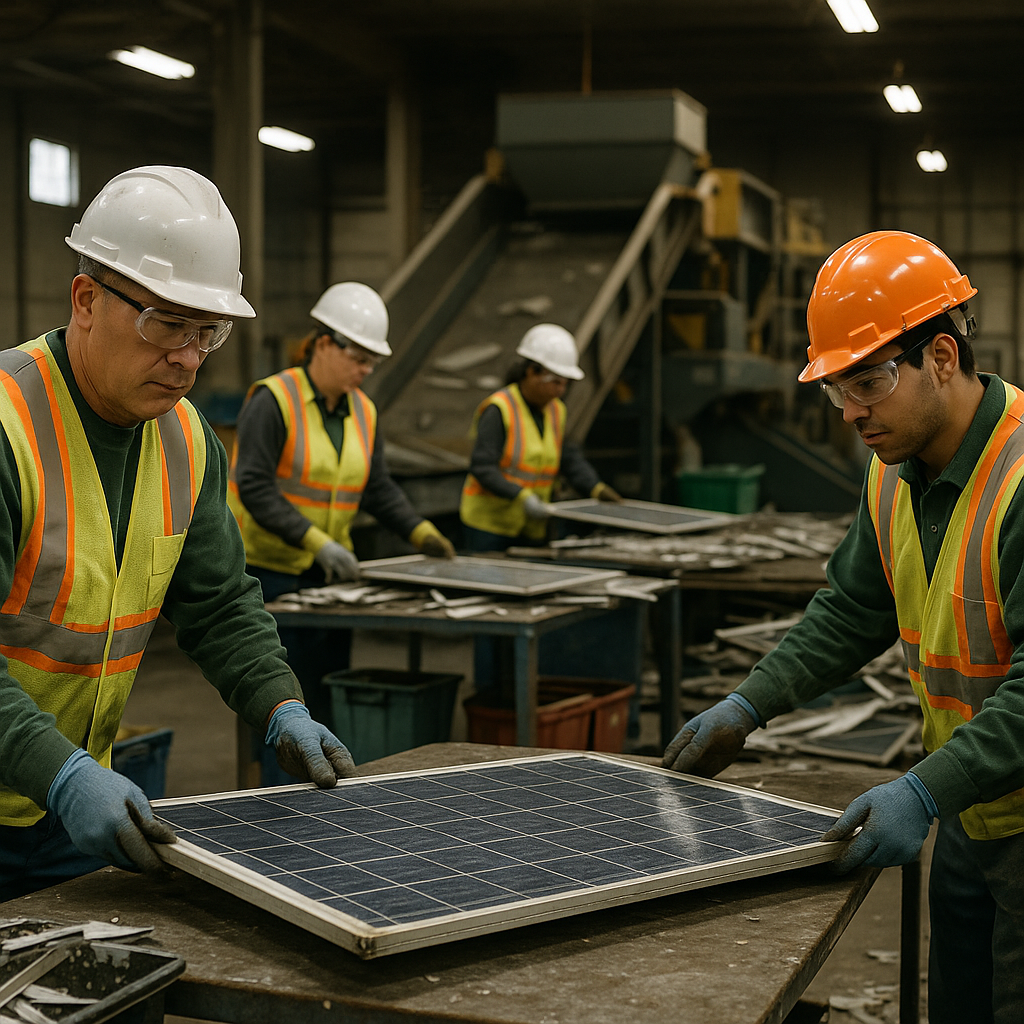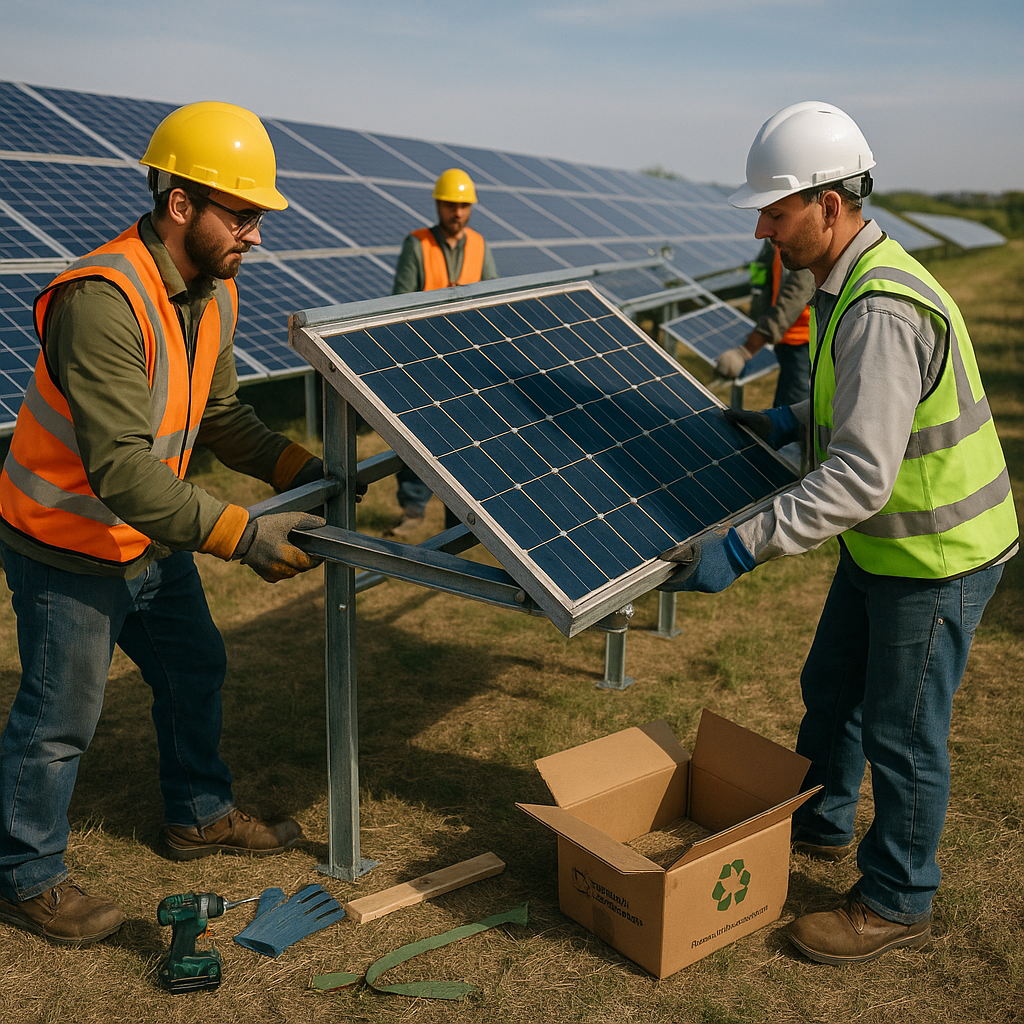5901 Botham Jean Blvd, Dallas, TX 75215
Everything You Need to Know About Solar Panel Material Recovery?
May 28, 2025Solar panel material recovery extracts valuable components from decommissioned photovoltaic panels. This specialized recycling process targets modules that have completed their 25-30 year operational lifespan or suffered early damage from weather events or manufacturing defects.
The recovery process separates aluminum frames, glass, silicon cells, and precious metals like silver and copper. Modern techniques can recover up to 95% of panel materials, preventing hazardous substances from contaminating landfills while reclaiming resources for reuse.
The economic potential of this industry is substantial. By 2030, experts project the global value of recoverable raw materials from end-of-life solar panels will reach $450 million. This amount equals the materials cost to produce approximately 60 million new panels, highlighting the circular economy benefits of proper solar panel recycling.
How Does the Solar Panel Recycling Process Work?

Solar panel recycling involves specialized processes tailored to different panel types. It begins with disassembling external components like aluminum frames, junction boxes, and cables, preserving valuable materials for recovery.
For crystalline silicon panels, which dominate the market, the process includes thermal processing at around 500°C. This breaks down binding materials, allowing separation of glass from silicon cells. Recyclers reclaim up to 95% of the glass and extract 85% of the silicon content.
Thin-film panels are shredded into small pieces, then separated into solid and liquid components. Special equipment sorts these materials, enabling efficient recovery.
Metal components like copper wiring and silver contacts are carefully extracted, representing some of the most valuable materials for reuse in electronics.
Advanced facilities use mechanical and chemical processes to maximize material recovery. Mechanical systems handle initial breakdown and separation, while chemical treatments purify materials to meet manufacturing standards.
The efficiency of solar panel recycling improves with technological advancements. Current processes recover about 90% of the aluminum and other metals, making recycling economically viable and reducing waste.
Some operations are developing automated systems with robots and AI to optimize separation, enhancing processing speed and recovery rates.
The final stage processes recovered materials for reuse. Glass cullet can be used in construction or new panels, metals enter commodity markets, and purified silicon may return to the solar supply chain or other electronics.
Material Recovery Efficiency
Recovery efficiency varies by material and method. Glass shows the highest rates at 90-95%. Aluminum achieves similar rates, while silicon recovery ranges from 80-85% with current technologies.
Metals like copper and silver, though in smaller quantities, have high recovery rates due to their value. Specialized processes extract over 90% of these metals from end-of-life panels.
Plastics and polymers present more challenges, with current processes recovering 70-80%. Some operations convert these polymers into fuel or useful chemicals.
Recovery efficiency also depends on panel condition, with undamaged panels yielding higher rates. This underscores the importance of proper handling during collection and transportation.
As technologies advance, total material recovery rates improve, with some facilities reaching 96% by mass, marking progress toward sustainable solar energy.
Economics of recycling improve with higher recovery rates. Valuable materials like silver, copper, and aluminum help offset costs. As more panels reach end-of-life, the industry is expected to become increasingly profitable.
Overall, solar panel recycling is crucial for renewable energy sustainability, reducing waste and providing resources for new clean energy technologies.
| Component | Monocrystalline Panels | Polycrystalline Panels | Thin-Film Panels |
|---|---|---|---|
| Glass | 95% | 95% | 90% |
| Silicon | 85% | 85% | 92% |
| Aluminum | 95% | 95% | 95% |
| Silver | 90% | 90% | 95% |
| Copper | 90% | 90% | 90% |
What Are the Challenges in Solar Panel Material Recovery?

Material recovery from solar panels faces significant economic hurdles. Current recycling costs range from $20-$30 per panel, while landfill disposal costs only $1-$2, creating a substantial price gap that discourages sustainable practices. This unfavorable cost-to-value ratio explains why approximately 90% of end-of-life panels end up in landfills rather than recycling facilities.
Material separation presents another major technical challenge. Modern solar panels contain multiple layers of glass, aluminum, silicon cells, and polymers bonded with ethylene-vinyl acetate adhesives. These adhesives require temperatures above 400°C to break down, making component separation difficult and energy-intensive. Current methods struggle to efficiently separate these materials while preserving their value.
Transportation logistics add further complications. Collection costs start at $0.05 per watt but can reach $0.25 per watt depending on site accessibility and panel volume. Shipping a single container holding 300-500 panels costs between $1,000-$2,000. These expenses make recycling economically challenging, especially for smaller operations or regions without local facilities.
Infrastructure Limitations
Recycling infrastructure remains underdeveloped in many regions. Most countries lack sufficient facilities to process the growing volume of decommissioned panels. The problem worsens as early solar installations from the early 2000s reach their 25-30 year end-of-life stage. This timing creates an urgent need for expanded recycling capacity.
Many recyclers need minimum waste volumes of 4,000 tons annually to maintain profitability. This requirement creates challenges for individual homeowners and small businesses seeking responsible disposal options. The wide geographic distribution of solar installations further complicates collection and transportation logistics.
European nations generally maintain better recycling infrastructure compared to other regions. This advantage stems from the EU’s early adoption of regulatory frameworks addressing solar panel waste. Many other countries still lack similar facilities, creating recycling deserts where sustainable disposal options remain limited.
Evolving Regulatory Landscape
Regulatory inconsistency presents significant challenges for the solar recycling industry. The European Union leads with its Waste Electrical and Electronic Equipment (WEEE) Directive, which classifies PV panels as e-waste and establishes recycling requirements. However, most other regions lack comparable frameworks.
The United States has no comprehensive federal regulations for solar panel recycling, resulting in a patchwork of state-level approaches. Washington State mandated manufacturer recycling programs in 2017. California classified end-of-life panels as universal waste. Other states like New Jersey, North Carolina, and Hawaii have implemented varying approaches.
This regulatory fragmentation complicates compliance for companies operating across multiple regions. Solar installation firms and recyclers must navigate different requirements in each jurisdiction, increasing administrative burdens and operational costs. The lack of standardization also creates confusion for consumers seeking proper disposal options.
Market Development Challenges
The solar panel recycling market remains in its early stages. Current processes recover primarily glass and aluminum, while more valuable materials like silicon and silver often go unreclaimed. The limited market value of recovered materials—typically $3-$8 per panel—fails to offset recycling costs.
Advanced recycling technologies show promise but remain costly to implement at scale. Thermal and chemical processes can recover up to 98% of materials with high purity levels. Some researchers have developed methods to extract over 90% of silver within just 10 minutes, but commercial application remains limited.
Despite these challenges, the recycling market shows significant growth potential. Industry experts project the market will expand from approximately $323 million in 2024 to between $548-$931 million by 2030. The value of recoverable materials could grow from $170 million to $2.7 billion by 2030, potentially improving the economic viability of recycling operations.
What is the Future Outlook for Solar Panel Material Recovery?
The global solar panel recycling market is on the brink of significant expansion. Financial projections indicate growth from £250 million in 2022 to £1.29 billion by 2028, marking a fundamental shift in solar panel waste management and resource recovery.
Several key drivers are fueling this growth. The increasing volume of end-of-life panels is the primary impetus as first-generation installations reach their operational limits. Additionally, regulatory frameworks worldwide are tightening to address proper disposal and recycling requirements for solar waste.
The economic potential of this market extends beyond waste management. By 2050, industry experts predict PV recycling will create substantial green job opportunities throughout the recycling value chain, from collection and transportation to advanced material recovery roles requiring specialized technical knowledge.
Notably, the recoverable value is estimated at approximately £11 billion by 2050. This recovery capacity could enable the production of 2 billion new solar panels without additional raw material investments, underscoring the environmental and economic impact of this circular approach.
Growth rates vary by region, with some markets showing particular promise. Research indicates that the Asia Pacific solar panel recycling market is projected to grow the fastest over the next decade, corresponding with the exponential increase in solar installations across China, Japan, and India in recent years.
The transition toward circular economy principles in solar energy represents a fundamental evolution in renewable energy sustainability. By recovering valuable materials like silicon, silver, and aluminum, the industry reduces dependency on resource extraction while minimizing environmental impact. This approach addresses the full lifecycle of solar technology rather than focusing solely on energy generation.
Advanced recycling technologies are emerging to improve recovery rates and processing efficiency. These innovations include mechanical-hybrid recycling techniques and chemical processes that enhance material separation. As these technologies mature, they will further increase the economic viability of material recovery operations.
The market growth pattern reflects a broader global commitment to sustainable practices across the renewable energy sector. This commitment ensures that solar energy’s environmental benefits extend beyond carbon reduction to include resource conservation and waste minimization.
Conclusion: The Circular Future of Solar Energy

Recovering materials from solar panels is crucial for establishing a circular economy in renewable energy. With advancements in recycling technologies, material recovery rates have significantly improved. Modern techniques can now reclaim up to 95% of semiconductor materials and 90% of glass from end-of-life panels. This progress transforms what could become 78 million tonnes of global waste by 2050 into valuable resources.
The economic potential is significant. By 2050, the solar panel recycling industry could recover materials worth approximately $15 billion, enough to manufacture 2 billion new panels without mining raw materials. This circular approach generates green jobs, reduces manufacturing costs, decreases environmental impacts, and ensures solar energy remains truly renewable throughout its lifecycle. For questions about responsible solar panel recycling solutions, contact Okon Recycling at 214-717-4083.
